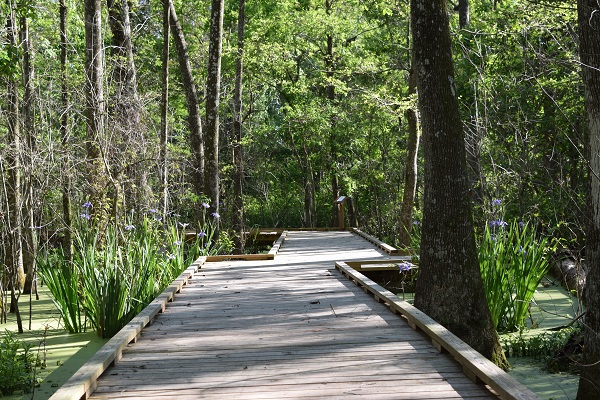Trees & Trails Signs
Wildlife Sign
- Forty-six different species of mammals have been spotted in East Baton Rouge Parish.
- The eastern fox squirrel (or red squirrel) is found only in the eastern parts of the United States and can usually be identified by its long, bushy red tail, though coloring does vary by community. Some fox squirrels may have a stark white nose or a dark black coat.
- The nine-banded armadillo and Virginia opossum are seen most often at night. During the day you can spot their tracks in the mud.
- The opossum has opposable thumbs and leaves tracks that look like tiny hands.
- Secure your garbage cans, and remember not to litter! Northern raccoons will eat just about anything, and they can easily become a nuisance.
- Scat deposited on a tree stump or log is a good sign swamp rabbits are nearby.
- Also found in Louisiana, the eastern cottontail is smaller and has more red in its coat than the swamp rabbit.
- iNaturalist.org is a great website for citizen scientists to record, share and discuss their wildlife sightings all over the world. Go to here to see who’s been recorded visiting LSU AgCenter Botanic Gardens.
Birds of Prey
- American kestrels are the smallest falcons, identified by their blue wings and white cheeks.
- Cooper’s hawks are the only hawks in the area that you will see chasing other birds for prey.
- Owls, such as the great horned owl, are best seen at night two weeks before the full moon when the moon is closest to earth and its light is brightest.
- The barred owl call asks the question, “Who cooks for you?” (hoo, hoo-hoo, hoooo)
- Red-tailed hawks can be seen soaring year-round throughout the United States and can often be seen in pairs hunting for small mammals.
- In the summer, look up! Mississippi kites come to Baton Rouge to breed and can easily be seen soaring overhead.
- At ebird.org, birders all over the world share their birding checklists. It is a great way to get an idea of which species are present in your area at certain times of year.
- One hundred five species of birds have been identified at the LSU AgCenter Botanic Gardens. Use our hotspot, LSU Burden Research Center, when making your own checklist or to see what others have spotted.
Watching Wildlife
- Spotting wildlife in their natural habitat takes patience and luck. To increase your chances, learning about the species you would like to see can give insight into when and where you will most likely find them.
- You can bring along a paper-bound field guide or use one of many online resources or apps for your phone.
- For bird information and identification, try one of these websites: sibleyguides.com, audubon.org, or allaboutbirds.org.
- For off-the-grid sightings where no service is available, a hard copy field guide will come in handy. Many are available for mammals, reptiles, amphibians, birds, plants, etc. Peterson Field Guides offers a variety of options. Visit the Peterson website at houghtonmifflinbooks.com/peterson.
- When observing wildlife, try to blend in to your surroundings as much as possible. Stay quiet, wear colors that blend (brown, dark green, gray), and avoid any perfumes or strong scents.
- A good pair of binoculars is an important investment for a dedicated wildlife watcher. Think about size, weight and weather hardiness when selecting a pair. Also, maximum magnification may seem important, but binoculars with a magnification above 10 can be difficult to steady and focus by hand.
Wetlands
- About 40 percent of United States wetlands are in Louisiana.
- Wetlands are defined as land with saturated soil for all or part of the year. This includes marshes, swamps, bogs and fens.
- Red-winged blackbirds are common in wetlands. The males are all black with bright red coloring under their wings. The females are more camouflaged in a drab brown and white. They have a lighter red to yellow spot under their wing.
- Louisiana’s wetlands are home to various wildlife, including mink, raccoon, coyote and alligator, and invasive species, such as the feral hog and nutria.
- In 1990, the Coastal Wetlands Planning, Protection, and Restoration Act was passed to prepare and fund wetland conservation projects.
